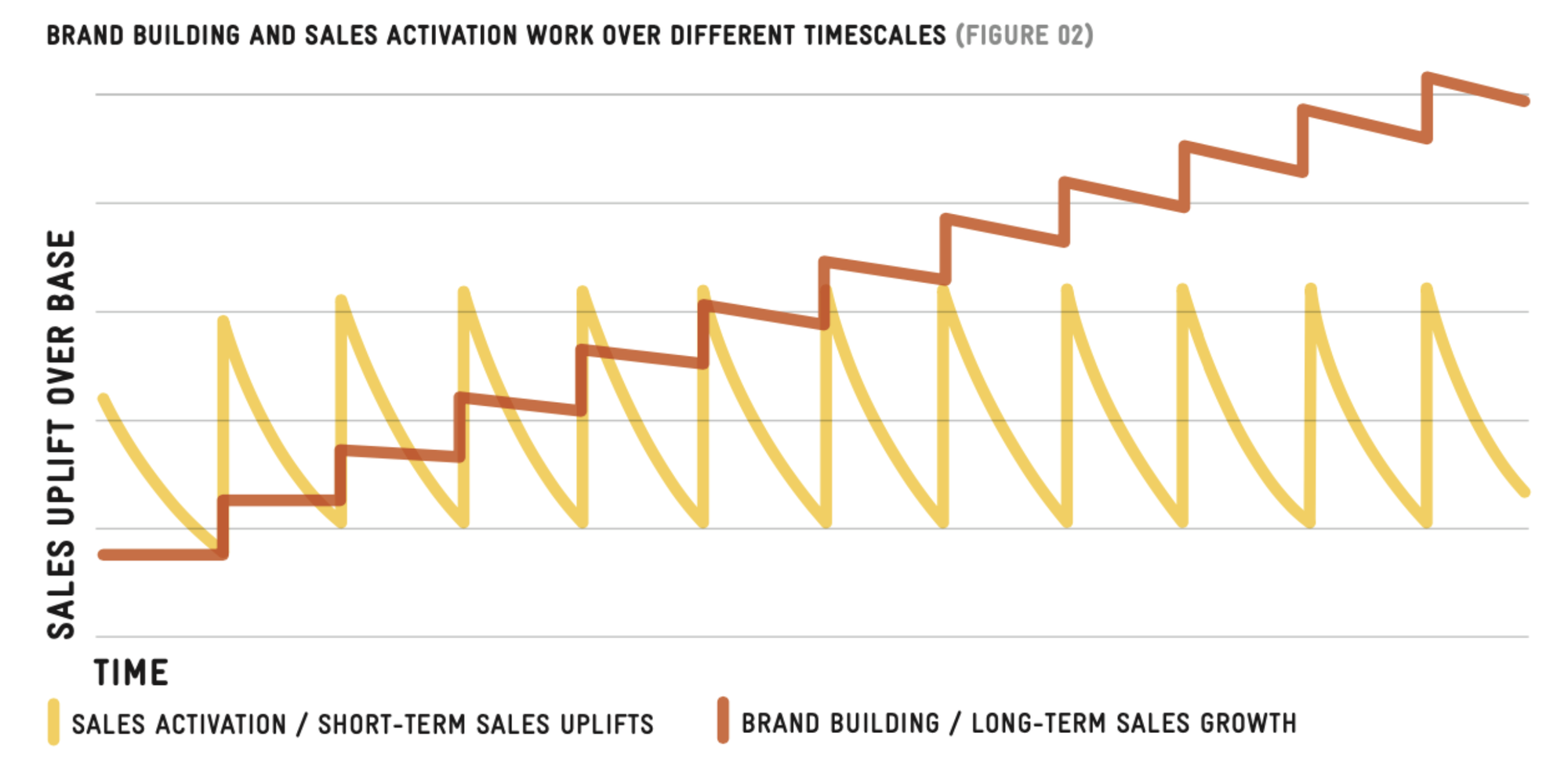How to start awareness advertising for long-term growth
Short-term goals are tempting for many B2B marketers. There's big pressure, especially for early-stage companies, to hit immediate sales goals — and this can lead marketers to focus their ads on capturing existing demand, driving demo requests and product signups.
But targeting the bottom of the funnel will only take you so far. It won't spur continual growth and in the long term. To do that, awareness campaigns also need to be a part of your strategy.
Andrew Breen, president of B2B digital advertising analytics company Outshine and Colin White, head of demand at Clearbit, share when it's time for your ad program to evolve and include awareness — and why. Read on for their crash course on awareness advertising — or check out their on-demand conversation.
Demand capture and awareness amplify each other
By focusing on capturing and converting latent demand, startups and earlier-stage businesses chasing those bottom-of-funnel conversions may see some big wins. But eventually those gains will taper off.
Latent demand is basically existing demand: people have a need but don't yet know there's a product or service that's available to satisfy it. With demand capture, you're leading them straight to the solution — which also means you're working within the bottom end of the funnel.
"The more aware someone is, the more ready they are to make a purchase and the more efficient that advertising used to reach them will be. But the volume is going to be less," Andrew points out.
Colin adds, "As you go capture that latent demand, you're not focused on creating it or bringing people into any awareness state from from totally unaware."
And that's when companies need to start layering in awareness to create new demand.
Research on B2B brands has shown that a brand is more likely to make it to a consideration-stage short list when a consumer can recall both types of ads (from Google and Deloitte Brand to Demand Study, 2018). "When a potential B2B buyer can remember both a direct response and an awareness ad — the likelihood of making that post-research shortlist goes up significantly versus them remembering just one ad or the other," Andrew explains.
Awareness campaigns give extra power to your demand capture campaigns and vice versa.
Awareness ads have a longer timeline but lower costs and higher growth potential
When brands begin to grow and get more investors, that's a great time to start working on awareness with a bigger budget. "You're getting in front of a broader audience, so you can capture current demand down-funnel, but also start priming the pump for future sales," Andrew says.
In fact, this can increase your sales over time. As the advertising experts Les Binet and Peter Field lay out, the sales uplift for awareness is actually greater over time:
 Les Binet and Peter Field, Media in Focus: Marketing Effectiveness in the Digital Era, IPA
Les Binet and Peter Field, Media in Focus: Marketing Effectiveness in the Digital Era, IPAAdding awareness advertising can also be less expensive than demand capture-only campaigns. For instance, if you target a bottom of the funnel keyword like "compensation management software", that might cost you $50 per click. But a broader awareness campaign that targets an audience interested in HR topics could cost only about $0.08 per video.
"So if you can drive 10 video views at 80 cents total. Then later, when someone's more interested in compensation management software and googles your brand, maybe your brand click was $3," Andrew says. That's a $3.80 investment versus a $50 investment.
Seeding that brand awareness versus targeting high-dollar keywords is much less expensive, but it does require an investment in your time. You have to start early and keep at it. "If you have the patience and the timescale to make the investments early on, they can really pay dividends, because you don't have to only fight where that cost per click is incredibly expensive," Andrew says.
3 keys to awareness advertising success
There are three keys to success with B2B awareness campaigns, and they all revolve around developing and keeping support for them in your organization.
1. Work on organizational buy-in — and repeat
Make sure stakeholders understand what you're trying to do with awareness campaigns, especially when there’s new management that needs to be brought up to speed. You can have a standard presentation deck ready to go for those situations.
"If you're not taking the time to explain what you're doing and getting buy-in, there's a good likelihood they're going to cut your budget," Andrew says.
When to pitch matters. "You really need to be hitting goals before you start, and you don't want to wait too long to actually pitch the strategy," Colin advises. It'll be much harder to make the case for awareness advertising without the proof of return from paid channels as a whole or if you wait too long until performance degrades so far.
Also, keep that buy-in fresh: reiterating and reinforcing again and again what you're doing and why.
"I have seen so many awareness campaigns," Andrew warns. "Somebody leaves who championed it, somebody new comes in, no one's telling the message of why they were doing it, and it gets cut. This happens over and over again."
2. Keep separate budgets
Have dedicated buckets for your advertising campaigns, so that awareness isn’t lumped in with your other efforts.
"If you have one big advertising bucket, what's going to happen is that the minute your short-term targets aren't being met, all of your awareness budget is going to be in your demand gen campaign," Andrew says. "With short-term pressures that you need to hit, it gets really easy to justify that cutting off."
3. Define success ahead of time
Define the goalposts for success, and protect them by explaining why those are the right goals before you get started.
Use guardrails to start. Look to industry benchmarks for what "good" looks like for awareness campaigns and make that your starting point to gauge whether you're in the right ballpark.
If you set goals like an average time on site, don't fall into the trap of answering questions about how many leads that is generating because that’s not the goal of awareness.
"Don't even entertain it," Andrew warns. It's hard to hold that line, but it’s important to keep those conversations separate from ones about awareness. If you do, you'll be held to lead-based objectives, despite all the work you've done to get buy-in on an awareness strategy.
Defining success ahead of time gives you the ability to make that distinction clear.
How to measure awareness campaign success
Executives and other stakeholders will want to see proof of your awareness campaigns' success.
There are three types of metrics to show awareness campaigns are working.
1. Absolute performance
Absolute performance is the straightforward metrics that show the impact of your campaigns. This is the most important measure.
"The absolute performance is what executives are looking for," Andrew says. "It's the thumbs up or the thumbs down. It's the 'this is working and how I can show you that.'"
The downside of absolute performance is that it can be hard to show and it takes a longer timeframe to measure.
The best example is branded organic search, which Andrew also considers the purest measure. (Total website traffic can be affected by things like advertising and tracking issues, but branded organic search is how many people are out there looking for you.) It takes time — a month, even a quarter, isn't long enough to see impact.
"But if you're consistent in the market and you're looking over a long enough time period, you can see a correlation between awareness advertising and branded organic search," he says.
2. Relative performance
Relative performance is simply comparing one number against another. These are the types of reports that marketers make on a daily basis. "It's 'Facebook is more efficient than LinkedIn,' or 'targeting A is better than targeting B,' or 'ad A is better than ad B," Andrew says.
It's an easier type of measurement, but relative performance reporting isn't going to get buy-in up the chain. Instead, use this measurement alongside absolute performance, so you can get better over time.
"Cost per engaged user is a really effective metric," Andrew recommends. "You can measure that by time on-site, or if you use Clearbit and can measure it, that's a phenomenal way."
3. Anecdotal evidence
Last but not least: anecdotal evidence. Don't underestimate its power!
You can gather "how did you hear about us?" information from simple surveys, building it into forms or signup processes, or getting feedback from salespeople.
Take note of social media activity, too like retweets and comments where someone says they love your ad or think your company is awesome.
One concrete way to show this evidence is to gather logos of companies that have engaged with your brand and become customers, thanks to awareness campaigns. "I love using Clearbit Reveal for this," Andrew says. "You look at the people who came from your awareness campaigns, take the best logos, and you put them on a slide to show what your awareness campaigns did."
More than any number, that visual representation of who you're reaching gets people onboard. "Those marketing stories and anecdotal evidence really gets people excited," Andrew says.
If you're only focusing on capturing latent demand, you're ignoring the rest of your market. There is a prime time to start making longer-term bets, without having to anchor success in leads and pipeline.
As tech-oriented, data-driven marketers, we can get distracted by numbers and measurements. "We can waste so much time trying to prove what we're doing," Andrew points out. "If we flip that and we spent more time thinking about offers, I think we'd be more successful overall."
Keep reiterating the impact and importance of your awareness campaigns. If you do, you’ll be able to keep creating new demand for your brand and product well into the future.


